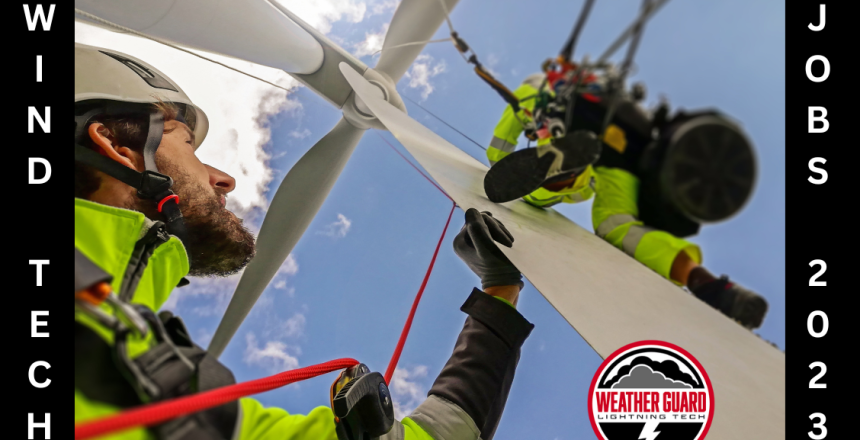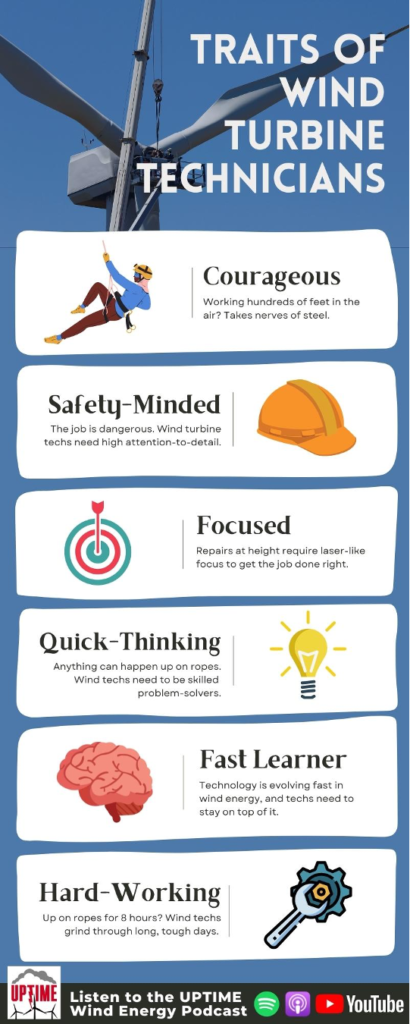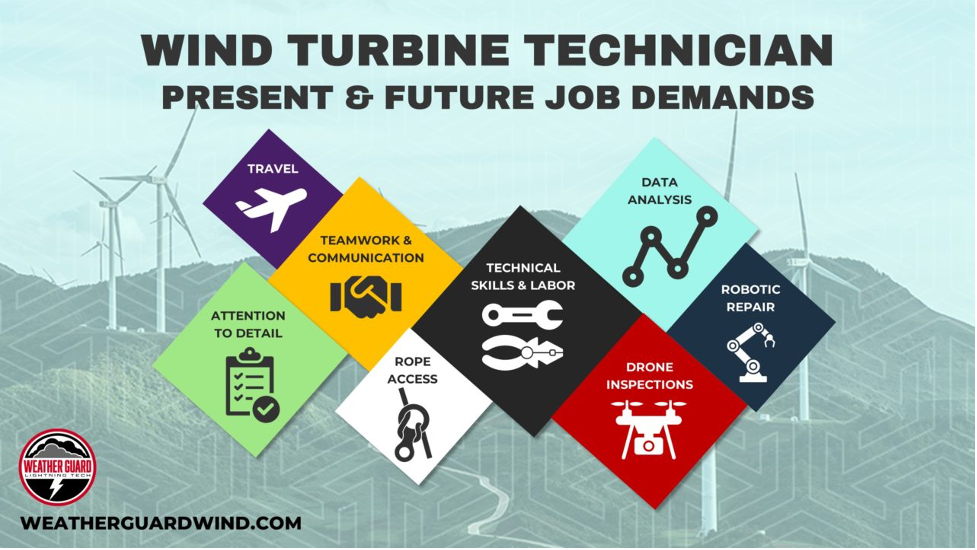Are you considering working in the wind industry? The job market for wind turbine technicians remains strong in 2023, and as the industry grows and wind technology improves, a wind turbine tech is likely to have more room for growth and promotion.
Employment of wind turbine technicians is projected to grow 44 percent from 2021 to 2031, much faster than the average for all occupations.
Still, it’s an unusual occupation, and the wind energy business is unfamiliar to many people. It’s a physical job, and one that comes with some risks. This guide address questions you may have about the work, job security, dangers, salary, and other benefits that go along with being a wind turbine technician.
While wind techs are in great demand in the US and worldwide, the career isn’t for everyone. Like many occupations, it can be a legacy role – not surprisingly, the children of wind techs are more likely to understand the demands of the job, and may be more likely to consider the field for themselves.
Still interested in pursuing a wind tech job? It’s a great choice for many people! Here are in-depth answers to some frequently-asked questions, and below you’ll find an even deeper dive into broader issues like lifestyle considerations, the actual nature of the work, and how it is likely to change in the near future.
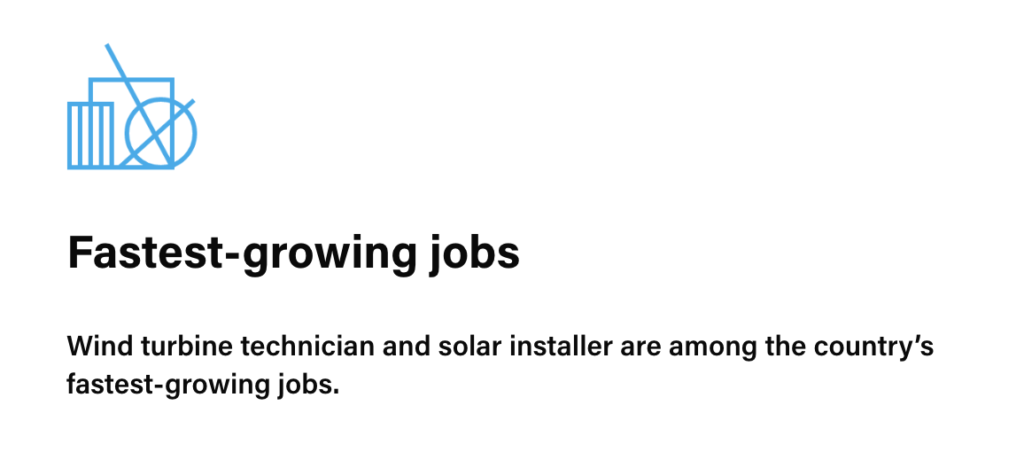
Podcast: inside the post-COVID wind turbine technician job market
Wind Turbine Technician Jobs FAQ
Weather Guard Lightning Tech does not employ wind turbine techs, however, we regularly communicate directly with technicians in the field who are installing our lightning protection products or preparing to go on a job site where lightning damage is a concern.
We also frequently host guests on The Uptime Wind Energy Podcast who discuss training for and working in the field. Notable interviews include Bjorn Hedges talking about wind power jobs and job safety and Michel Goulet of Petzel discussing safety gear and training for wind turbine technicians and others who work at heights.
Working at heights in the wind energy industry or any other carries certain risks. Because companies in the industry must maintain excellent safety records and training, each year there are very few fatalities and serious injuries. Training demands an understanding of a wind turbine’s electrical circuits and machinery – as well as the nacelle – and training on the tools used. Generally, ropes and other safety gear (PPE or personal protective equipment) are inspected on each job site and are regularly replaced due to wear, and as advances in safety programs and materials are made – such as new brake technologies, discussed in the Petzel interview.
The minimum requirements to become a wind turbine technician vary by company, but generally a candidate must be at least 18 years of age and have completed a certification course at a community college or technical school. Once hired, new wind techs typically complete an on-the-job training program lasting between 12 and 18 months. Additionally, many wind turbine technicians engage in specialty training related to wind power systems, such as hydraulic, electrical, braking or maintenance operations.
A college degree is not required; however, wind turbine technicians must have at a minimum a completion certificate from a certified trade school or training program. Most companies look favorably on some college, especially engineering and electrical courses. And, of course, every company requires its technicians to periodically qualify on specific tests and training modules – the BLS characterizes it as a position with “long term on-the-job training.”
If you’re looking for a job that offers some great travel opportunities, wind technician could be it! However, some wind technicians – particularly those working with a utility or large wind farm operation – may work at a single location for years. Even in those cases, it’s worth noting that because most wind farms are located in remote areas, the typical “commute” for a wind turbine technician may be considerably longer than workers in more urban locations. Other wind techs are employed as traveling technicians. Wind techs who specialize in a certain types of damage repair (such as leading edge repair) or have special knowledge of specific models of turbine blades, gearboxes, or sensors may travel nearly every week of the year.
The median salary of a wind turbine technician in May 2021, according to the U.S. Bureau of Labor and statistics, was $56,260 ($27.04/hr). The same source indicated that the average median annual salary for wind techs in professional, scientific, and technical service was $63,640.
As of this writing, the US Bureau of Labor Statistics ranked wind technicians as the second-fastest growing occupation in the US (behind nurses), and American Clean Power concurs.
The jobs outlook through 2031 is a growth rate of 44%, or much faster than the average career field, with BLS anticipating 4900 additional jobs. And, based on demand in the market, earning potential may be higher. Because that BLS figure was published prior to the passage of the Biden Administration’s Inflation Reduction Act of 2022 (IRA), which includes new federal tax incentives for wind energy projects, we anticipate that those projections may be adjusted upward. A greater demand in the workplace naturally increases earnings and benefits.
“Every day is going to be different,” according to a wind tech working in the Midwest. While wind techs often work alone on discrete tasks, they are not alone on a job site. Most days start with a briefing from a manager at the site, and techs are often dispatched in small teams. Some wind operations companies maintain wind technician staffs on job sites and dispatch from a common location or locations. While the job requires self-sufficiency and the ability to work alone, some people are surprised to realize it is not necessarily a “lonely” job.
So, what does a wind tech do? There really is no such thing as a typical day, but generally, tasks revolve around monitoring, maintaining, troubleshooting, and upgrading the electrical, mechanical and hydraulic systems related to the wind turbine nacelle and/or blades.
Increasingly, turbine tower and blade inspections require operators to use robots or drones in addition to, and sometimes instead of, rope access technicians.
A simple “no” is the answer. However, there’s no doubt that the industry is relying on robots for more and more data-gathering and monitoring tasks. The proliferation of robots and monitoring systems in the wind industry is all good news for wind techs.
Working with robots makes the wind technician more productive, and effective, and most importantly, safer.
Quick read: the latest on robotic wind turbine inspection and protection
While it’s true – and exciting – that new robotic technologies have been developed to better monitor, clean, and even repair some nacelle components and parts of wind turbine blades, those robots cannot replace wind technicians. They are the new tools of the trade!
Listen to the interview with BladeBUG founder Chris Cieslak, and more exciting updates from the interview with Cieslak and DoneBase founder Greg Lorenz here.
Wind turbine blade repair is also often part of the job. Because blades are routinely worn and damaged by lightning, rain storms and other environmental factors, many wind techs develop specialties in blade repair. Blade inspections and repairs are also done using robots or drones – but even those tasks typically require a tech to be on the site, or to control the robot from a monitoring site.
Listen: 3 common types of turbine blade lightning damage
Regarding turbine blade repair and other specialties, while a mechanical or electrical background is helpful, most techs gain their experience and expertise in company-sponsored training and on the job.
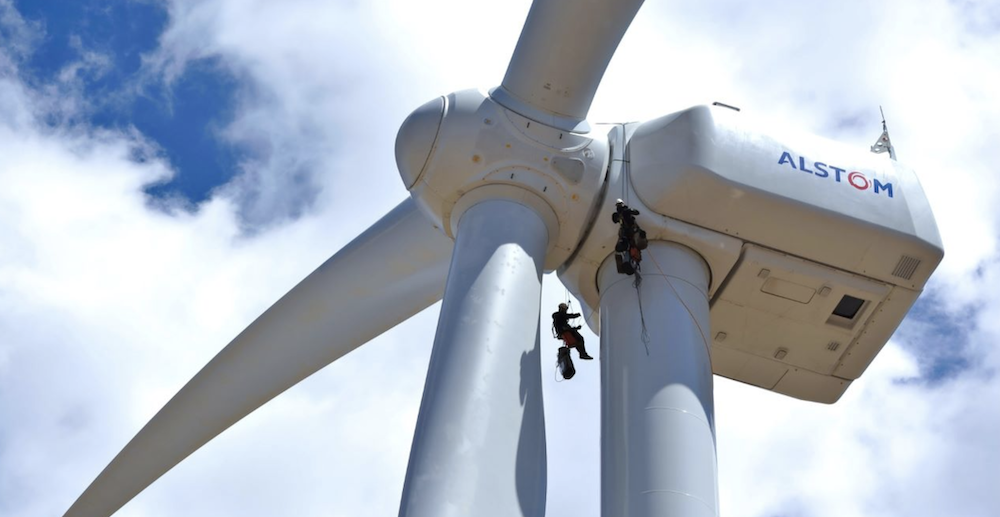
Wind Tech Job Requirements
Even as robots and drones are utilized more in the field, for the foreseeable future, a wind technician’s job will remain more physically demanding than many jobs.
In spite of increasing use robots and drones, wind technicians will always be required to have:
- The physical capability to lift heavy items, crawl, work at height or in confined spaces
- Good communication and interpersonal skills, as well as the ability to make decisions and work independently
- The ability to gather and interpret data, including learning to control robots and drones
- Willingness to work outdoors, in all types of weather, and in remote areas, potentially off-shore
Wind Tech Lifestyle & Other Considerations
If a physically active, technical job and working regularly, but not always, outdoors sounds good to you, you might want to consider a career as a wind technician. Another important factor to consider is that travel is usually – but again, not always – part of the job. According to one wind tech, that means the job takes “a certain mindset,” because work may take you away from family for extended periods of time. Also, because most wind turbine operations are located in rural or remote areas, if you love big city life, working as a wind tech may not be a good fit.
Finally, because some of world’s biggest wind turbines are located in off-shore wind farming operations, many wind tech job sites include marine locations.
Where to Find Wind Technician Job Listings
When you’re starting a search for jobs in wind energy, the major career sites including LinkedIn, ZipRecruiter, and SimplyHired list jobs for all experience levels. At the time of this writing, we found positions offering up to $88,000/year with job titles that included:
- Wind Turbine Technician, or Wind Technician
- Wind Turbine Traveling Technician
- Wind Composite Blade Technician
- Main Component Repair Technician
- Wind Turbine Troubleshooting Technician
Wind Energy Technology Resources
The more you know about an industry, the better prepared you are to be hired into it. While face-to-face networking in the wind energy field may not be easy to do – unless you have friends or family members in the industry – there is a vibrant online community in wind energy. Most major employers and manufacturers in the industry have active social media feeds and many conduct informative webinars, often for free. Connecting through online networking groups is another option. The weekly Uptime Wind Energy Podcast and companion newsletter [with free subscriptions to both] provides insight from engineers and business professionals on news and wind power industry technology developments.

Additional Resources
- American Clean Power
- Global Wind Energy Council
- US Bureau of Labor and Statistics – Wind Technicians
- Energy.gov Career Map for Wind Technicians
- Workforce Training and Education: Wind Energy
- Safety: OSHA on Green Job Hazards
- Safety: ASSE paper on Wind Turbine Safety
- Safety: ASSP Standard for Wind Turbine Construction and Demolition
- Vestas Wind Systems statement on safety and sustainability

